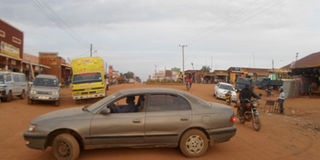Braving clouds of dust to Sembabule

A few cars dot Sembabule town. Salon cars are the most common means of commuter transport. PHOTO BY ROLAND D. NASASIRA.
What you need to know:
MAIDEN TRIP. I had never been to Sembabule. It was a dusty trip in the vicinities of Masaka. Roland D. Nasasira shares his experience.
On a hot Tuesday afternoon, two colleagues and I boarded a taxi to Ntuusi Sub-county in Sembabule – 160km from Masaka. It took between three to four hours-drive from Kampala town.
Through Masaka and after crossing to Kalungu district, the tarmacked road ended. A murrum road, with pothole after pothole welcomes us. It is not easy to miss the bigger part which is swampy that sandwiches the road and scanty homesteads either sides. Even with the thick clouds of dust, the driver could did not slow down because most of the passengers had been complaining about the unnecessary stopovers he made, on top of having passed by a garage in Mengo to change the engine oil. This had lasted 30 minutes.
More dust
After about five kilometres, I asked my colleague, John, about the remaining distance to our destination. “It is about 80km to go,” he answers with ease. I reserved other questions. I could not imagine going the remaining distance with the taxi windows closed due to the thick clouds of dust.
Having taken a back seat, every pothole we hit, bounced us off the worn out cushions as our heads hit the roof and back. This did not stop me from hugging tightly, my laptop bag.
We had left Kampala at about 3.30pm. It clocked 7pm and were still braving the potholes. I started doubting the four hours-drive John had talked about. Then, we reached what seemed like a busy trading centre. I got shocked to learn that it was Sembabule town. A beehive of activity it was as motorcyclists ferried people from and to different directions. My concern was if the residents would ever live to see a tarmacked road.
On the way
Wherever our speeding car passed and did not stop, locals had to reach for handkerchiefs and scarfs in their pockets, to cover their noses and faces. We persevered the potholes for about 20 more kilometres, and finally arrived at Ntuusi trading centre at 8.05pm. It did not look any different from Sembabule town.
John told me that Lwemiyaga Parish is part of Ntuusi Sub-county. I could not help but remember the legislators from that place who were a few months back occupied with debating the president’s retirement age. It is a trading centre that has the basics such as; power, retail shops and salons or barbershops and a fuel station with two pumps. The most reliable means of transport here are motorcycles. Vehicles used are mostly Toyota Premio, Toyota Coronas and Toyota Ipsum some of which have no side mirrors.
The return
After a night of work at Meru Meru Village, Lwemiyaga Parish in Ntuusi Sub-county, I could not wait to get back on the road, again to Kampala. All taxis destined for Masaka left quite early, we had no option but to board a Toyota Premio. The drivers use every tactic to make money from travellers either to Masaka or Sembabule.
Another bumpy ride
In the Toyota Premio, the driver’s seat was shared by two people just like the codriver’s. The rear seat meant for three people was occupied by five. “When I get passengers who are of an average body size like you, six of them can fit behind there,” the driver, who refused to disclose his name as we travel, explained. His posture saw him drive with his head out of the car window.
After about two hours of the bumpy ride, we arrived at Total fuel station, Nyendo in Masaka where a private car awaited us. It is a journey that I will never forget. I doubt if I will ever go back to Ntuusi by public means, unless I have assurance that the road has been tarmacked.
Quick notes
Sembabule was cut out of Masaka district in 1997. It is bordered by Mubende district in the North, Gomba district to the Northeast, Bukomansimbi district to the East, Lwengo district to the South, Lyantonde district to the Southwest and Kiruhura district to the Northeast.
Sembabule District covers a total surface area of 2319.2 kilometres with a population of 180,045 as per the 2002 population and housing census.




